Posts Tagged ‘Retail’
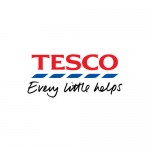
The Chartered Institute of Marketing defines marketing as “the management process responsible for identifying, anticipating, and satisfying customer requirements profitably”. Definition of marketing offered by American Marketing Association, on the other hand, is worded as “the activity, set of institutions, and processes for creating, communicating, delivering, and exchanging offerings that have value for customers, clients, partners, and society at large” (AMA, 2014, online) Alternatively, marketing can be defined as “a business orientation that focuses on satisfying customers’ needs at acceptable levels of revenues and costs” (Loudon et al., 2010, p.2). Elements of marketing process of Tesco contain the following: 1. Analysis of the market and environment. Strategic tool to conduct this analysis include PESTEL, SWOT, Porter’s Five Forces, Value-Chain analysis and others. 2. Identification of the marketing target. Tesco targets specific segment of population in the UK and other countries where the supermarkets of the company operate. 3. Setting marketing objectives. Marketing objectives of Tesco include profit maximisation in short-term and long-term perspectives and increasing the value of the brand image. Marketing objectives of Tesco are closely associated with their business strategy which consist of the following seven elements (Vision and Strategy, 2013, online): a) to be growing the UK core, b) increasing international presence through offline and online channels, c) growing retail services in present markets, d) focus on corporate social responsibility, e) enhancing brand value, f) engaging in more diversification and g) creating value through teamwork. 4. Dealing with elements of the marketing mix. The importance of dealing with each elements of marketing mix taking into account needs, wants and other unique characteristics of target customer segment is fully understood by Tesco management. 5. Reflection, control and revision. This element of marketing process is used by Tesco marketing management in a periodic manner in order to assess the levels of effectiveness of…
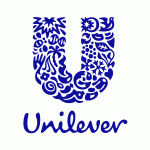
Unilever is a global consumer products manufacturer that achieved EURO 50 billion turnover with over 173,000 employees in 2012 and its portfolio includes such famous brand names as Dove, Magnum, Knorr, PG, Hellmann’s and others (Annual Report and Accounts, 2012). Unilever specifies its purpose as ‘to make sustainable living commonplace’ Unilever has formulated its vision as “double the size of the business, whilst reducing our environmental footprint and increasing our positive social impact”. The mission statement of the company has been worded as “meeting the everyday needs of people everywhere”. Unilever Organisational Stakeholders and their Objectives The following table represents Unilever organisational stakeholders and their objectives Stakeholders Objectives (expectations) Achievement of objectives Internal stakeholders Employees Adequate compensation and working environment Effective organisational culture More than EURO 5,1 billion 173,000 paid to employees in 2013 A set of effective employee social protection programs Managers Career growth opportunities Challenging working atmosphere Unilever Facebook global careers page attracted 110,000 ‘likes’ within 6 month of launch Owners Long-term growth of the company Consistent profitability growth for numbers of years External stakeholders Government Adherence of the company to rules and regulations Payment of appropriate amount of taxes in a timely manner Unilever criticised for basing 26% of its subsidiaries in ‘tax heaven’ countries such as Costa Rica, Philippines, Guatemala, and Hong Kong (Ethical Consumer, 2012) Suppliers Long-term partnership in a mutually beneficial manner Unilever possesses Fairtrade Certification for the majority of its products Society High levels of corporate social responsibilities Development of Unilever Sustainable Living Plan Commitment to reduce greenhouse gases by 50% by 2020 Development of Sustain Ability Challenge Creditors Effective management team Adequate level of equity Consistent rise of profitability for a number of years Increasing brand value Shareholders Long-term growth of the company The full year dividend in 2012 increased to…
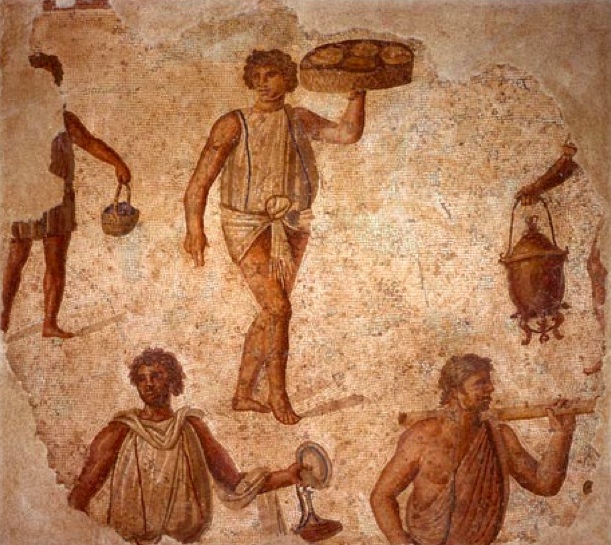
The evolution of selling had several distinct phases of development during the course of late 19th and 20th centuries. Industrial revolution of late 19th century caused a tremendous amount of exchange of goods between people and nations all over the world. Strategic resources at this time were capital and resources companies controlled. Therefore sales success was defined by meeting sales quotas. This period can be roughly defined from 1860s – 1960s. However from 1960s a new age in the area of selling has started. It was an Information Age. From 1960s till now information has radically changed how selling is being conducted, methods and attitudes towards selling. In this age, strategic resource of the business is information and it is defined by customer relationships. Adding value is the primary success criteria of the selling process. Of course these are generalised notions of the evolution in selling. There are exceptions and plenty of businesses who are doing things old school and don’t want to adjust to modern reality. Moreover there are businesses which are following century old techniques and methods used by their founders and finding themselves niches in the market where they are successfully operating. One of them is Avon – direct and door to door seller of women’s cosmetics. In this part of the essay professional selling which gained momentum during the industrial revolution and kept serving business well until post-WWII times will be discussed in detail. Major advances in manufacturing and transportation made possessing resources and capital a major aim for business. This naturally required skilled people with talents in persuading and providing goods to a broad range of customers. As selling and exchange goods at this scale were unknown to humankind up until this point, buyers were relatively unsophisticated and could have been easily manipulated towards making…

Consumer buyer behaviour is considered to be an inseparable part of marketing and Kotler and Keller (2011) state that consumer buying behaviour is the study of the ways of buying and disposing of goods, services, ideas or experiences by the individuals, groups and organizations in order to satisfy their needs and wants. Buyer behaviour has been defined as “a process, which through inputs and their use though process and actions leads to satisfaction of needs and wants” (Enis, 1974, p.228). Consumer buying behaviour has numerous factors as a part of it which are believed to have some level of effect on the purchasing decisions of the customers. Alternatively, consumer buying behaviour “refers to the buying behaviour of final consumers, both individuals and households, who buy goods and services for personal consumption” (Kumar, 2010, p.218). From marketers’ point of view issues specific aspects of consumer behaviour that need to be studied include the reasons behind consumers making purchases, specific factors influencing the patterns of consumer purchases, analysis of changing factors within the society and others. Authors How to define consumer behaviour Findings Faison and Edmund (1977) “The assumption that people have series of needs which lead to drive state.” Needs Engel, et al. (1986) “Those acts of individuals directly involved in obtaining, using, and disposing of economic goods and services, including the decision processes that precede and determine these acts” Acts, individuals Kotler (1994) Consumer behaviour is the study of how people buy, what they buy, when they buy and why they buy. Solomon et al. (1995) Consumer is the study “of the processes involved when individuals or groups select, purchase, use, or dispose of products, services, ideas, or experiences to satisfy needs and desires” Process, needs, individuals, group Schiffman (2007) “the behaviour that consumers display in searching for,…

Kotler and Keller (2011) state that the importance of studying consumer buying behaviour as an area of marketing is increasing due to several factors. In order to offer any product or service to the customers businesses must understand their customers’ culture, social group and many other factors. Understanding these factors helps businesses to draw an effective marketing plan in order to satisfy the needs and wants of their customers in more efficient way. Another reason for increase the importance of the study of customer buying behaviour is intense pace globalization. According to Nargunkar (2008), globalization has changed the way the businesses operate and target their customers. As more and more businesses are operating in more than one country, they need to understand the different cultures and characteristics of their customers. As businesses grow geographically, their customer bases change and the needs of customers in one country varies from the needs of the customers in another country. Therefore, the study of consumer buying behaviour is essential in order to target all the customers in all different geographical areas. In addition, studying the consumer buying behaviour is essential especially in conditions of fierce competition in the market. As the number of companies in the same industry which offer the similar or even the same products or services to the customers, these businesses need to target the right segment. To make this happen, it is important to understand the buying behaviour of the customers Lancaster et al (2002). Another factor leading to the importance of learning customer buying behaviour is rapid advancements in the technology. Due to the development of information technologies and IT systems, learning the customer buying behaviour has become more practical and easier. It is also stated that the large and multinational businesses are investing significantly on improvements of their…
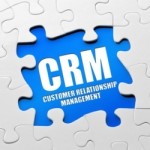
Customer relationship management has been defined as “a business approach that integrates people, processes, and technology to maximise relationships with customers” Goldenberg (2008, p.3). Moreover, it has been stated that customer relationship management “characterises a management philosophy that is a complete orientation of the company toward existing and potential customer relationships” (Raab et al, 2008, p.6) Mueller (2010) characterises customer relationship management aspect of the business as a highly dynamic, and convincingly argues that businesses have to adopt a proactive approach in devising relevant programs and initiatives in order to remain competitive in their industries. Sinkovics and Ghauri (2009) relate the necessity for engaging in customer relationship management to high cost of direct sales, highly intensifying level of competition in the global level, and need for information about various aspects of the business in general, and consumer behaviour in particular, that can be used to increase the levels of sales. According to Peppers and Rogers (2011), there is global tendency in customer relationship management that relates to the shift from transactional model towards the relationship model. In other words, Peppers and Rogers (2011) argue that satisfying customer needs as a result of on-time transaction is not sufficient today in order to ensure the long-term growth of the businesses. Instead, businesses have to strive to maintain long-term relationships with their customers in order to maintain flexibility to adopt their increasing expectations and thus achieving their life-long loyalty. Peppers and Rogers (2011) further stress that, businesses that refuses to acknowledge this tendency in the global marketplace would be risking their market share and growth prospects in the future. One of the most critical sources for the research is the book “Relationship Marketing and Customer Relationship Management” authored by Brink and Berndt (2009). The book offers an in-depth discussion of the concept of…
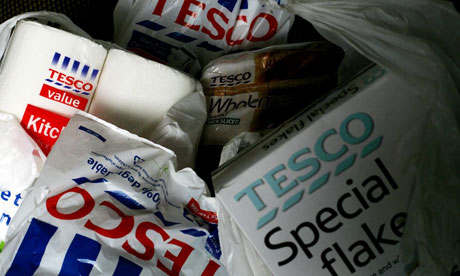
One of the popular definitions of policy reads as “a statement by government – at whatever level – of what it intends to do about a public problem” (Birkland, 2010, p.9). Accordingly, the issues of policy process are mainly discussed in the literature in relation to government policies. Tesco packaging policy is based on the following five key principles: being fit for purpose, using the lightest materials in terms of weight, using materials from the most sustainable sources, maximising the opportunities for recycling and recovery, and designed in a way that the lowest carbon impact can be achieved (Waste and packaging, 2012, online). According to Peters (2009) the Stages Model of Policy Process consists of the following stages: issue emergence, agenda setting, alternative selection, enactment, implementation and evaluation. All of these stages can be analysed in an individual manner in relation to the packaging policy of Tesco. Issue emergence of the policy process is an initial stage when specific problems are identified that need to be dealt with. Issues that require the introduction of relevant policies may arise fuelled by a wide range of reasons such as disasters, or any other dramatic changes. In terms of Tesco packaging policy this stage corresponds with increasing role of corporate social responsibility (CSR) aspect of the business in general, and the level of ‘greennes’ in particular. In other words, defined as responsibilities of business towards society apart from profit maximisation (Blowfield and Murray, 2008), CSR has emerged as a crucial aspect of the business to be dealt with by Tesco. The agenda setting stage of policy process corresponds with the issue growing to an extent that it requires immediate and due attention. It has been stated that “agenda setting occurs when the key players focus on an issue problem, which can be…
January 2, 2013
By John Dudovskiy
Category: Corporate Social Responsibility
Tags: Ethics, Retail, Sustainability
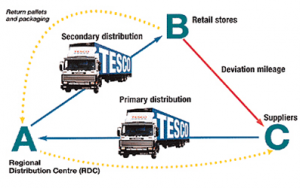
To meet the high expectations of on-time delivery while keeping the delivery costs low, e-grocers need to use fairly advanced optimization techniques and information technology systems. With every grocery retailer there is a flow of finished goods from its suppliers, then from the company to its customers. Grocery retailers also exchange and receive information which provides valuable data for the system. These include feedback from the marketplace in the form of customers’ orders, customer reaction, and information on needs and wants; flows of information within the company that provide data in the form of inventory schedules, production schedules and so on as well as orders from the company to outside suppliers’. From a standpoint the whole company and the market in which it operates can be deemed as a series of linkages and relationships, and the efficiency in which the company operates can be seen to depend on how well these connections work. Having a system that works smoothly at minimum cost, would possibly allow for the company performance to be high. However this is not always the case in practice where it is common to find bottlenecks and poor integration between different parts of this system, leading to disappointing results. There are various methods and systems that can be implemented by retailers and over the past years the big supermarkets tried to adopt centralised models but where quick to abandon them in the past decade once they realised they would struggle with being efficient. This excludes Ocado which remains at the other end of the spectrum. ‘Ocado maintains that its centralised model will prove more efficient than the supermarkets’ store-picking approach once it achieves a critical mass’. The drawback is that Ocado might incur some difficulties if its tries to implement the hub and spoke system for the entire…

E-Shopping SWOT Analysis Strengths A company’s ability to compete in its chosen industry highlights the level of success that it can achieve. Ocado is a clear example of how an organisation can create its own niche by specialising in a fraction of the actual industry therefore working against the usual business model of supermarkets. Although existing companies might already have an advantage with infrastructure a company’s strength will become evident if it is able to implement the e-commerce principle to expand its customer base whether it be on a local or global scale without expending too much time or capital that leads to its downfall. For an existing company, having a standard brick and mortar supermarket although deemed as an initial advantage, would not necessarily be the same for a new entrant. Having low overhead and start up costs for an e-shopping retail business would be more beneficial. These benefits though can extend to the consumer. Having an online business in this period is more of a necessity and consequently would allow a company better levels of communication which is achieved at every stage of the purchase especially through the use of e-mail. Weaknesses A customer in this market has no way of identifying the size of the company via the internet and consequently cannot identify the capabilities of the chosen company. Consequently a customer demands the same level of service from a new small online business as it would from a retail giant. A new company also has the task of identifying and understanding consumer behaviour, customer values and expectations therefore a new entrant is left with the task of designing and structuring a website that assists the consumer in locating the exact product that is desired as well as allows it to assert its position in a…

E-shopping commonly known as Electronic Commerce refers to the buying and selling of information, products and services via computer networks. (Kalakota and Whinston 1997) The global market for online grocery retailing remains at a relatively early stage of development in many parts of the world. To date, sales of food and drinks over the internet have yet to make the same impact observed in other parts of the consumer goods industry, most notably books, clothing and electronic items such as computer equipment. (www.companiesandmarkets.com) It has become clear that most of the existing retailers use the online service as an extension of the service that they provide in house. This allows them to provide another convenient element for the customer that might not be able to visit a store for the products that they require. Evidently retailers see their presence on the internet as an opportunity to further meet the needs of their customers employing the motto of ‘If you can’t come to us, we’ll come to you’. With most major supermarkets now competing online as well as offline, competition in the UK is intensifying to offer added value services to online customers, above and beyond the mere delivery of groceries (Robinson et al 2007). There is clear evidence to show that a lot of companies have tried to venture into this peculiar part of this industry and have subsequently failed. It remains clear that very little has been done to date to understand the evolution of consumers’ motivations, likes and dislikes when purchasing groceries online, as they become more experienced with this mode of shopping. (Robinson et al 2007). Meanwhile the sector remains dominated by store-based grocers such as the likes of Sainsbury’s, Tesco and Waitrose that have remained resilient in an ever changing and adapting industry and have enjoyed…
